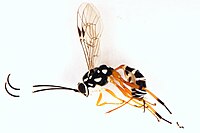|
Glabridorsum stokesii
Glabridorsum stokesii is a species of parasitoid wasp belonging to the family Ichneumonidae first described by Peter Cameron in 1912, known to be a generalist parasite of species including crop pest species such as the codling moth and Grapholita molesta. The species is native to southeastern Australia, and has been introduced to New Zealand. TaxonomyThe species was originally named Gambrus stokesii by Peter Cameron in 1912. The species was reclassified as Ischnus stokesii by Henry Keith Townes, Marjorie Chapman Townes V. K. Gupta in 1961; reclassified a second time as Glabridorsum stokesii in 1970 by Henry Keith Townes.[2] DistributionThe species is native to southeastern Australia. It was introduced to New Zealand between 1969 and 1974 as a measure to combat moth species that impacted fruit growing, and successfully established in Auckland and Hawkes Bay.[3] By the 2020s the species had become common across both the North Island and South Island of New Zealand, and identified in the Australian states of Queensland, New South Wales, Victoria and Tasmania.[4] Between 1932 and 1939, attempted introductions of Gambrus stokesii were conducted in the United States as a part of pest control programmes, however the species failed to establish.[3] DescriptionBelow is Cameron's original description:
Cameron's female holotype measured 7 mm (0.28 in) in length, and was found in Glen Innes, New South Wales in January, laying eggs in weevil larvae.[1] BehaviourGlabridorsum stokesii is a generalist parasite,[5] known to be a parasite of the codling moth and Grapholita molesta, the oriental fruit moth.[3] ParasitesGlabridorsum stokesii is a host to two species of parasitoid wasp, Gelis cinctus and Gelis tenellus.[6] Gallery
References
External links
|
||||||||||||||||||||||||||||||||
Portal di Ensiklopedia Dunia



